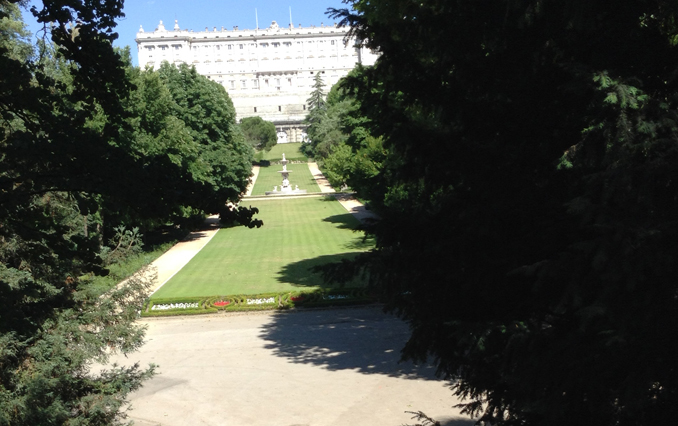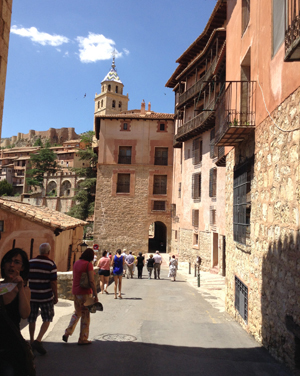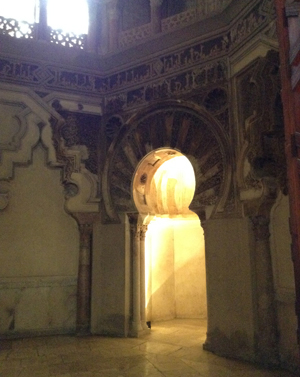Written by: Dr. Dushka H. Saiyid - Posted on: August 04, 2014 |  Comments | 中国 (Chinese)
Comments | 中国 (Chinese)
Google Translation: اُردو | 中文
711 was a significant year for the expansion of the Umayyad empire: the stripling Muhammad bin Qasim arrived in Sindh, which began the spread of Islam in South Asia, while Tariq bin Ziad and his band of 10,000 men on their fiery steeds, crossed the Straits of Gibraltar in the same year. Muslims rulers replaced the Visigoths, the Germanic tribes, who had invaded the peninsula from the north.
I was curious to see what legacy the eight hundred years of Muslim rule had left in Spain. My interest lay in the little known taifs (independent Muslim kingdoms) of Albarracin and Zaragoza in the centre and north of Spain, as Al Andalucia, with its architectural gems in Granada and Cordoba, is already well known. But my quest began in Madrid, with a visit to the neglected ruins of its Moorish past.
The Moors had made Madrid into a garrison town in the 9th century. Where Palacio Real or the Royal Palace now stands, was once the Muslim fortress of Mayrit, built on a ridge guarding the garrison town against the Christian invaders. All that remains of the Mayrit is a fragment of the wall, known as Muralla Arabe. We found the fragment of the wall after some searching, but then there it was, in a well-maintained little park, amongst bushes of lavender. But dominating the skyline and dwarfing the remnants of the old fort was the Catedral de Nuestra Señora de Almudena, where once the fortress was.
 |
Palacio Real overlooking Campo del Moro |
At the back of the Palacio Real are the beautiful grounds of the Campo del Moro (Moors Field), named after the deadly battle that took place when an Almoravid (a Berber dynasty) army laid siege to the city in 1110. The Moors were able to take all except the fortress, where now stands the Palacio Real, overlooking the gardens. The Christian army was able to hold on, and the Almoravids eventually withdrew. This field of 20 hectares was developed into beautifully laid gardens in the eighteenth and nineteenth centuries. Tall trees rustle in the soft wind of summer; the souls of the fallen Moors seem to be whispering as we walk through the shady paths. A canon on display is the only reminder of the ferocious battle that had raged here between not two religions, but two civilizations.
 |
Streets of Albarracin |
ALBARRACIN was our next stop, a small village east of Madrid that has been built on a rocky outcrop in a deep valley with the river Guadalaviar flowing through it. It is one of the most beautiful villages of Spain that has been declared a National Monument. It was the seat of a tiny Islamic state or taif as they were called, ruled by the Berber dynasty of Banu Razin from 1012 – 1104, with links to Cordoba.
Crowning this old town of narrow and steep cobbled streets is the old castle that was a military outpost. It has eleven towers and covers an area of 3600 square meters. The archaelogical digs have revealed, amongst other things, the system of flowing water used to keep the bathing and toilet area clean and hygienic. Earlier our guide had shown us the house of an elite family of Alabarracin. When asked about their toilet facilities, we were informed that the ground floor, where the animals were kept, was used for that purpose. The Moors were known for their use of running water, public baths and personal hygiene, quite alien to the Europeans of the time.
 |
Mihrab for offering prayers, Aljaferia |
ZARAGOZA, because of its strategic location, has a rich Roman and Islamic heritage. It was the capital of the Upper March, the frontier territories of Al Andalucia. The palace of Aljaferia, the residence of the Banu Hudd dynasty, was built in the second half of the 11th century in the taifa of Zaragoza. When Zaragoza fell to Alfonso I in 1118 AD, the palace became the home of the Christian Kings of Aragon. It is the finest example of Islamic architecture outside of Al Andalucia. The central courtyard of the palace has finely carved arches, floral motifs, Arabic inscriptions from the Holy Quran, a prayer room and a mihrab (a niche for offering prayers). Upstairs are rooms added by the Christian rulers from the 12th to the 14th centuries, and then the Catholic monarchs palace, whose Throne Room or Salon de Trono, has exquisite Mudejar (those who continued as Muslims even after the Reconquista, and their architecture which has heavy Moorish influence on it) architecture.
Granada was the last to fall in 1492. Jews and Christians had been allowed to practice their religion under Muslim rule but had to pay a tax or jizya. With the success of reconquista, Jews and Muslims were either expelled or under Queen Isabella’s decree of 1502, forced to convert to Catholicism, and the ferocious Inquisition followed, ensuring Catholic orthodoxy and the total elimination of any other religious community.
Allama Iqbal wrote a poem “Hispania”, on his return from a visit to Granada and Cordoba in 1933:
 |
Spain! You are the trustee of the Muslim blood:
In my eyes you are as sacred as Muslim holy lands.
 |
Prints of prostration lie hidden in your dust,
Silent calls to prayers in your morning air.
Click to view picture gallery